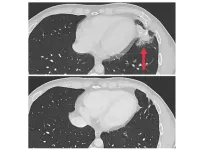(Press-News.org) Key takeaways
The International Astronomical Union defines a planet as a celestial body that orbits the sun, is massive enough that gravity has forced it into a spherical shape, and has cleared away other objects near its orbit around the sun.
Scientists now recognize the existence of thousands of planets, but the IAU definition applies only to those within our solar system.
The new proposed definition specifies that the body may orbit one or more stars, brown dwarfs or stellar remnants and sets mass limits that should apply to planets everywhere.
Planetary scientists are proposing a new definition of a planet to replace one that many researchers view as sun-centric and outdated. The current definition — established in 2006 by the International Astronomical Union, or IAU, the organization that officially names objects in space — specifies that to qualify as a planet, a celestial body must orbit the sun within our solar system.
But scientists know that celestial bodies orbiting stars outside our solar system are fairly common, and a forthcoming article in the Planetary Science Journal argues for a new definition of a planet that includes being unrestrained by the bounds of our solar system. The proposal also provides quantitative criteria to further clarify the definition of a planet.
Jean-Luc Margot, lead author of the article and UCLA professor of earth, planetary and space sciences and of physics and astronomy, will present the proposed new definition at the IAU General Assembly in August 2024.
Under the current definition, a planet is a celestial body that orbits the sun, is massive enough that gravity has forced it into a spherical shape, and has cleared away other objects near its orbit around the sun.
“The current definition specifically mentions orbiting our sun. We now know about the existence of thousands of planets, but the IAU definition applies only to the ones in our solar system,” Margot said. We propose a new definition that can be applied to celestial bodies that orbit any star, stellar remnant or brown dwarf.”
The authors argue that while the requirement to orbit our sun is too specific, other criteria in the IAU definition are too vague. For example, it says a planet has “cleared its orbit” without stating what that means. The proposed new definition contains quantifiable criteria that can be applied for defining planets inside and outside our solar system.
In the new definition, a planet is a celestial body that:
orbits one or more stars, brown dwarfs or stellar remnants and
is more massive than 1023 kg and
is less massive than 13 Jupiter masses (2.5 X 1028 kg).
Margot and co-authors Brett Gladman of the University of British Columbia and Tony Yang, a student at Chaparral High School in Temecula, California, ran a mathematical algorithm on the properties of objects in our solar system to see which objects clustered together. The analysis revealed groups of distinct qualities shared by planets in our solar system that can be used as a starting point for creating a taxonomy for planets in general.
For example, if an object has enough gravity to clear a path by accumulating or ejecting smaller objects nearby, it is said to be dynamically dominant.
“All the planets in our solar system are dynamically dominant, but other objects — including dwarf planets like Pluto, which is not a true planet, and asteroids — are not,” Margot said. “So this property can be included in the definition of planet.”
The requirement for dynamical dominance provides a lower limit on mass. But potential planets can also be too big to fit the new definition. Some gas giants, for example, are so large that thermonuclear fusion of deuterium occurs, and the object becomes a substar called a brown dwarf and therefore not a planet. This limit has been determined to be the mass of 13 or more Jupiters.
The current requirement to be spherical, on the other hand, is more problematic. Distant planets can rarely be observed in enough detail to ascertain their shape with certainty. The authors argue that the shape requirement is so difficult to implement that it is effectively useless for definitional purposes, even though planets are generally round.
“Having definitions anchored to the most easily measurable quantity — mass — removes arguments about whether or not a specific object meets the criterion,” Gladman said. “This is a weakness of the current definition.”
The good news is that, in the solar system, celestial bodies larger than 1021 kg appear to be round. So all bodies that satisfy the proposed lower limit on mass of 1023 kg are expected to be spherical.
While any official change to the IAU definition of planet is likely a few years away, Margot and his colleagues hope their work starts a conversation that results in an improved definition.
END
Scientific definition of a planet says it must orbit our sun; A new proposal would change that
2024-07-11
ELSE PRESS RELEASES FROM THIS DATE:
Advanced imaging reveals how a parasitic ‘kiss’ alters cell metabolism
2024-07-11
Toxoplasma gondii is a parasite responsible for toxoplasmosis, a lifelong chronic infection prevalent in about 30% of the human population. It poses little harm to healthy individuals but can result in severe consequences for immunocompromised people. If infection occurs during pregnancy, the parasite can cross the placenta and cause retinal or neurological issues in the developing fetus, and potentially death in severe cases.
There is currently no vaccine for Toxoplasma infection, and the biological mechanism by which the parasite affects the metabolism of host cells is still understudied.
In new research ...
New medication for stress urinary incontinence? Investigational drug shows promise
2024-07-11
Waltham — July 11, 2024 — An investigational medication designated TAS-303 shows efficacy and safety in treatment of women with stress urinary incontinence (SUI), reports a placebo-controlled clinical trial in the August issue of The Journal of Urology®, an Official Journal of the American Urological Association (AUA). The journal is published in the Lippincott portfolio by Wolters Kluwer.
"Our study adds new evidence that TAS-303 reduces the frequency of incontinence episodes in women with SUI, without the worrisome adverse ...
Warm or cold: Hibernation status matters when white-nose syndrome pathogen infects bats
2024-07-11
The fungal pathogen that causes white-nose syndrome (WNS) in bats uses different cell entry strategies depending on the host’s hibernation status – cold and inactive, or warm and active. The findings, which required the authors to develop a new bat cell line, highlight potential therapeutic interventions against WNS using epidermal growth factor receptor inhibitors, like the Food and Drug Administration-approved drug gefitinib. Bats – the second-most diverse group of mammals – play an important part in mitigating agricultural pests and the spread of insect-borne disease. However, millions of hibernating bats across North America are dying from ...
Barley’s rapid climate-driven adaption revealed in century-old biological experiment
2024-07-11
Leveraging one of the world’s oldest biological experiments – which began in 1929 – researchers have uncovered how a major crop, barley, was shaped by both agricultural pressures and its changing natural environment. The results underscore the power of long-term studies in understanding the dynamics of adaptive evolution. The survival of cultivated plants after their dispersal across different environments is a classic example of rapid adaptive evolution. For example, barley, an important neolithic crop, spread widely after domestication over 10,000 years ago to become a staple source of nutrition for humans and livestock throughout Europe, Asia, and Northern ...
Stratospheric air intrusions drive new particle formation in the upper troposphere
2024-07-11
New atmospheric particles form when stratospheric air intrudes into the troposphere below, according to a new study, revealing a previously unrecognized mechanism for new particle formation (NPF) in the upper troposphere. The finding suggests that NPF in these regions aloft occurs frequently and over large geographic regions, representing an important source of particles in the free troposphere. Aerosol particles smaller than one micron in diameter are abundant in the troposphere, the lowest layer of ...
Respiratory bacteria ‘turns off’ immune system to survive
2024-07-11
Researchers from The University of Queensland have identified how a common bacterium is able to manipulate the human immune system during respiratory infections and cause persistent illness.
The research, led by Professor Ulrike Kappler from UQ’s School of Chemical and Molecular Biosciences, studied the virulence mechanisms of Haemophilus influenzae, a bacterium that plays a significant role in worsening respiratory tract infections.
“These bacteria are especially damaging to vulnerable groups, such as those with cystic fibrosis, asthma, the elderly, ...
Structured electrons with chiral mass and charge
2024-07-11
Have you ever placed the palm of your left hand on the back of your right hand, in such a way that all fingers point in the same direction? If you have, then you probably know that your left thumb will not touch its right counterpart. Neither rotations nor translations nor their combinations can turn a left hand into a right hand and vice versa. This feature is called chirality.
Scientists at the University of Konstanz have now succeeded to imprint such a three-dimensional chirality onto the wave function of a single electron. They used laser light to shape the electron’s matter wave into left-handed or right-handed coils ...
Learning dance moves could help humanoid robots work better with humans
2024-07-11
Engineers at the University of California San Diego have trained a humanoid robot to effortlessly learn and perform a variety of expressive movements, including simple dance routines and gestures like waving, high-fiving and hugging, all while maintaining a steady gait on diverse terrains.
The enhanced expressiveness and agility of this humanoid robot pave the way for improving human-robot interactions in settings such as factory assembly lines, hospitals and homes, where robots could safely operate alongside humans or even replace them in hazardous environments like laboratories or disaster sites.
“Through expressive and more human-like ...
Women and social exclusion: The complicated nature of rejection and retaliation
2024-07-11
New research from the University of Ottawa (uOttawa) has provided a complicated glance into young women’s responses to interpersonal conflict, with retaliation often the answer to rejection and perceived social exclusion by other females.
The study, published in Nature’s Scientific Reports, highlights the complicated nature of women’s interpersonal relationships by examining the stress arising from rejection, and if the personal characteristics of those imposing the rejection influences ...
Immunotherapy approach shows potential in some people with metastatic solid tumors
2024-07-11
Early findings from a small clinical trial provide evidence that a new cellular immunotherapy approach may be effective in treating metastatic solid tumors. In the trial, researchers from the National Institutes of Health (NIH) genetically engineered normal white blood cells, known as lymphocytes, from each patient to produce receptors that recognize and attack their specific cancer cells. These initial findings are from people with metastatic colorectal cancer who had already undergone multiple earlier treatments. The personalized immunotherapy shrank tumors in several patients and was able to keep the tumors from regrowing for up to seven months. ...




